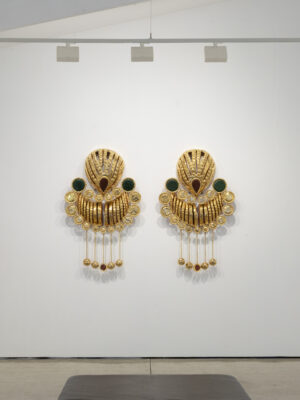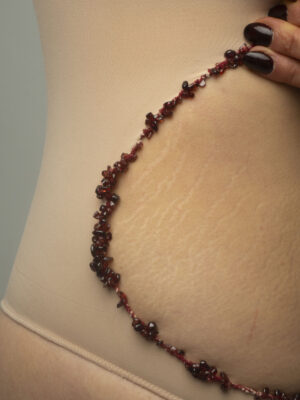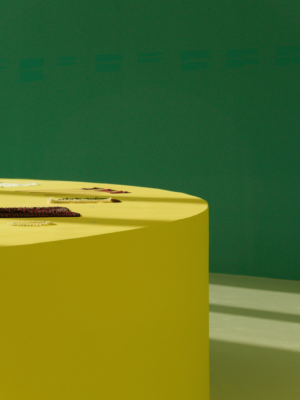These are some of the questions that artist Monica Rani Rudhar explores in her deeply personal art practice, which revolves around creating oversized terracotta sculptures of jewellery that has been passed down, gifted or sold in her family. Strikingly finished in gold leaf and bright glazes, these artworks are odes to her family’s history as well as statements of longing and love. ‘What I like about creating earrings in a larger scale is that they become monuments to lost heritage, but also monuments to ways I can feel connected,’ Rudhar tells me when I visit her Sydney-based studio.
To understand why lost heritage is an important theme in Rudhar’s practice, we must first understand who she is and where she comes from. Rudhar was born and raised in Australia. Her Romanian mother immigrated to Australia when she was just 17 and later became estranged from her family. Her father moved to Sydney from India at a similar time in the 80s. ‘As some-one who has mixed heritage, I sometimes feel that I belong to no culture fully,’ Rudhar reflects.
Her sense of disconnection and fragmentation is heightened due to most of her relatives living overseas. Growing up, she describes feeling ‘like I was missing out – I’d hear friends speaking about hanging out with their Pop. When you realise you don’t have something, you realise there is a gap.’
In an attempt to address this gap, Rudhar takes a restorative autobiographical approach to creating, basing her works on real items that belong or belonged to her family. The act of making has allowed her to begin to know her relatives and their lives more deeply.
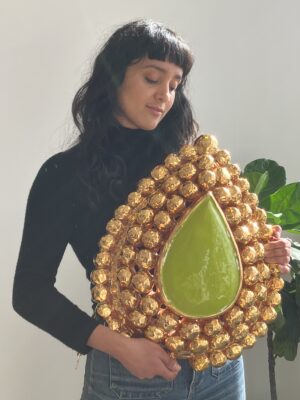
Take, for example, her work Dadi Ji’s Earrings 2 (2023) which is based on a beautiful story which only emerged a few years ago. The large-scale sculpture represents a pair of earrings that her father commissioned a brother-in-law to make as a gift to his mother in the mid 80’s. One day, Rudhar’s grandmother made the difficult decision to pawn these earrings in order to help a relative in need. ‘When he found out about this, my father was so upset,’ Rudhar recounts. Unbeknownst to anyone, her Aunty found out what had happened and bought them back. She kept them quietly for decades until finally, just two years ago, Rudhar’s Aunty told her father that she owned the missing earrings, later gifting them to Rudhar. ‘When she gave them to me and told me the story, I burst into tears because I thought ‘Oh my gosh, these were worn by my Grandmother,’ Rudhar says. ‘It was this beautiful story of loss and preservation and the different role that people play in keeping stories safe.’
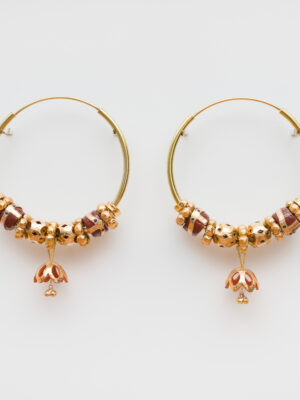
These heirlooms are particularly meaningful to Rudhar as she never got the chance to know her paternal grandmother, who suffered a tragic heart attack as she was about to immigrate to Australia. Despite this, Rudhar feels that she knows her through her father who ‘has such a great love for his mother, he always talks about her. She sounded like she was a very strong and progressive woman for her time.’ The earrings, too, have allowed her to get to know her Grandmother.
The story of how the earrings in question were created provides clues as to why Rudhar has such a strong pull towards jewellery. Many of her family members past and present are connected to the industry. ‘My ancestors are all goldsmiths and I’ve got my cousin who now owns a gold shop in Punjab, another cousin working in gems, and an uncle who makes gold chains – so there is this beautiful lineage,’ she explains.
While Rudhar’s sculptural work now focuses almost exclusively on jewellery and family connections, this was not always the case. It was only during the Covid lockdowns of 2020, that she began exploring distance, family and loss in her artmaking. ‘I realised how much grief I have been holding about not having such close connections to family members,’ she reflects. Another draw towards jewellery for the artist is its cultural importance in India.
Jewellery in India is not simply a form of fashion or decoration but is intrinsically linked to celebrations, rituals, religions, power and financial security. ‘You’re able to see the very important position of jewellery in Indian society at all times and at many levels,’ the curator Susan Stronge told The Guardian when speaking about the Bejewelled Treasures exhibition at the V&A that explored 400 years of Indian jewellery in 2015. As an example, she cites that ‘Indian courts have always had huge treasuries … if you lose the treasury you lose power, so jewellery has a fundamental importance in Indian history.’*
‘What’s been really beautiful about showing these ceramic jewellery pieces are the conversations that I’ve had with people from different cultures about significant heirlooms that are passed down or have been lost.’
—Monica Rani Rudhar
Furthermore, Anisha Parmar, a jeweller, designer and host of the podcast Empowered Adornment: Gold Jewellery Stories, highlights in her podcast that jewellery has played a major part of empowering women in India, providing them with financial security through gold and precious stones. ‘It was their one thing,’ she says. Similarly to Rudhar, Parmar is a member of a diasporic South Asian community, growing up in London and now living in Derby, UK. Her podcast delves into the importance of jewellery in a migrant’s journey and significance of the memories these pieces hold in connecting those far away with their culture.
In an episode focusing on jewellery inherited from Grandmothers, Parmar strikingly summarises these objects’ importance and value beyond their material worth: ‘These handcrafted gold pieces take on the material form of a family’s legacy and accumulate personal stories as they pass through the hands of their keepers […] transporting us to places we’ve never been to and telling stories we’ve never heard,’ she says. ‘We now adorn them with pride, feeling our ancestors lifting us as we navigate new cultural codes in the land where they brought us for better opportunities in the hopes we can make them proud and carry on their legacy.’**
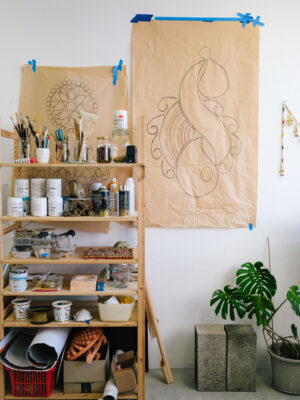
Rudhar says that she is drawn to jewellery as she is generally ‘a very sentimental person – I really love heirlooms and precious objects.’ This sentimentality however was not shared by everyone in her family. Her nearly two metre tall pieces Hoops That Once Belonged To My Mother (2022) and Drop Earrings That Once Belonged To My Mother (2022) are based on earrings that Rudhar’s father gifted her mother but, because jewellery’s significance manifests differently in Romanian culture, were not kept. These lost heirlooms ‘felt like another hurdle to accessing my heritage,’ Rudhar says, ‘it felt like another thing that had been taken away.’
Seeking to reclaim them in sculptural form, Rudhar contacted members of her family and worked with her parents as translators to gather photos and verbal descriptions of the earrings. This collaborative, investigative and restorative research process allows Rudhar to connect with objects that can no longer be seen, held or examined to be recreated.

The result are sculptures that have a strong presence when hung in galleries, museums, public spaces and homes. The strength of her work largely comes through their ambitious scale – blowing something up in size is to pay attention to it, to claim its importance and share it with others. ‘When the pieces are on the wall, there’s this feeling of reverence – they feel like an ode to history,’ the artist reflects.
Rudhar’s works and practice are deeply personal, yet over the last five years of exhibiting, the artist has discovered that audiences strongly connect with them. ‘What’s been really beautiful about showing these ceramic jewellery pieces are the conversations that I’ve had with people from different cultures about significant heirlooms that are passed down or have been lost,’ she says. ‘What’s been even more amazing has been meeting other individuals from the South Asian diaspora who have similar stories, it’s made me realise: Oh my gosh, I’m not alone. Other people feel like this too.’
Rudhar’s practice asks: How can objects help us to discover who we are? What her works teach us is that a restoration of culture and connection with heritage doesn’t only come by making odes to the past but also in using the process of creating these ideas to forge new connections and bridge the distance between ourselves and others.
Cover image:
Drop Earrings That Once Belonged to My Mother, 2022, terracotta, glaze, lustre, chain, wire, 125 x 163 cm. Installed at Martin Browne Contemporary, image by Jessica Maurer, courtesy of the artist.
*M. Brown, ‘V&A exhibition will explore 400 years of Indian jewellery’, The Guardian, 18 No-vember 2015, https://www.theguardian.com/artanddesign/2015/nov/18/va-exhibition-will-ex-plore- 400-years-of-indian-jewellery (accessed 5 November 2025).
**‘Kiran & Krishna – Grandmothers’, Empowered Adornment: Gold Jewellery Stories with An-isha Parmar [podcast], Interviewer and co-producer Anisha Parmar, United Kingdom, 2021, https://www.anishaparmar.com/blogs/news/empowered-adornment-episode-3-grandmothers (accessed 5 November 2025).
Lara Chapman is a writer, editor and curator who lives in Sydney, Australia on Gadigal land. She writes about design, architecture, technology and craft, often exploring how these areas intersect with the climate crisis and hidden histories. Her work has appeared in The Guardian, MacGuffin, Diesgno, DAMN, The Architectural Review and Real Life, amongst others.
Having lived and worked in London for the past twelve years, Lara was assistant editor at Disegno, working across print publications, digital publishing and podcasts. She was assistant curator at the Design Museum, London where she helped to develop and tour critically acclaimed exhibitions including ‘The Offbeat Sari’, ‘Waste Age: What Can Design Do?’ and ‘Yinka Ilori: Parables for Happiness’.
Lara’s independent curatorial projects have been shown at the V&A, Dutch Design Week, the Embassy of Internet and other places. She has delivered lectures on design to students at Kingston University, Design Academy Eindhoven and the University of London.
This year’s theme for our digital publishing is Language. Through a selection of articles we dive into visual languages, the communication of objects, iconography and symbolism. Focusing on story-telling through a lens of aesthetics, we are eager to bring assorted trains of thought to you by twelve different authors. The articles range from speculative to theoretical, chaste to raunchy, past to future, bringing you a variety of voices and perspectives.
This year’s digital publishing features isabel wang pontoppidan as guest editor. isabel is a Danish-Chinese writer, artistic researcher and jewellery maker based in Amsterdam. Her practice is multi-pronged, combining writing, performance, research and jewellery in a variety of overlapping cross-sections.
New Open Call For Writers 2026 is out now! Read more here via current-obsession.com/open-call-for-writers!
